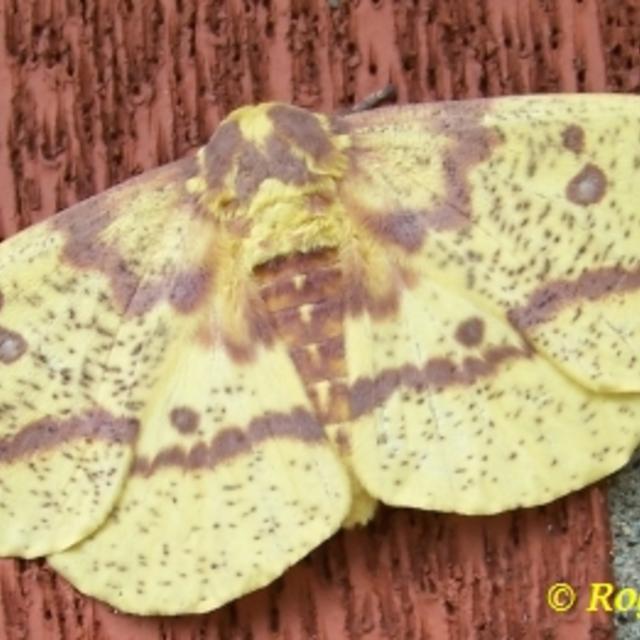Imperial moth
Eacles imperialis (Drury, 1773)
Family: Saturniidae
Subfamily: Ceratocampinae
Identification: Females are larger than males. Upperside is yellow with pinkish brown to purple-brown patches, bands, and cell spots, and tiny brown spots scattered overall. Males have larger patches on the forewings than females, except for some subspecies pini males which have reduced purple and are mostly yellow.
Wing Span: 3 1/8 - 6 7/8 inches (8 - 17.4 cm).
Life History: Adults emerge before sunrise and mate after midnight the next day. Females lay eggs at dusk singly or in groups of 2-5 on both surfaces of host plant leaves. The eggs hatch in about 2 weeks, and the caterpillars are solitary feeders. Pupation takes place in underground burrows.
Flight: One brood; in the north from June-August, in the south from April-October.
Caterpillar Hosts: Conifers and deciduous trees and shrubs including pine (Pinus), oak (Quercus), box elder (Acer negundo), maples (Acer), sweet gum (Liquidambar styraciflua), and sassafras (Sassafras albidum). Confirmed feeding on Norway spruce (see record 738773). Subspecies pini feeds only on conifers.
Adult Food: Adults do not feed.
Habitat: Deciduous and evergreen forests.
Range: Maine west to eastern Nebraska, south to the Florida Keys and central Texas. Subspecies pini occurs across the northern Great Lakes basin and the northern third of Michigan's Lower Peninsula.
Conservation: Not usually required.
NCGR: G5 - Demonstrably secure globally, though it may be quite rare in parts of its range, especially at the periphery.
Management Needs: None reported.
Get your BAMONA Gear!
Please donate!
We depend on donations to keep Butterflies and Moths of North America freely available. We want to express our gratitude to all who showed their support by making a contribution this year. You can donate to support this project at any time.
Advertise with us!
Do you have a product or service that you think would interest BAMONA users? If you would like to advertise on this website, contact us by email, or use the contact form and select the "Advertising" category.
Verified Sightings
Displaying 1 - 24 of 2702 verified sightings

Observation date: Oct 07, 2024
Submitted by: katherinethegreat1
Region: Highlands County, Florida, United States
Verified by: curtis.lehman
Verified date: Oct 16, 2024

Observation date: Jul 08, 2024
Submitted by: bknupp
Region: Rockingham County, Virginia, United States
Verified by: rogerdowner
Verified date: Oct 12, 2024

Observation date: Sep 25, 2024
Submitted by: Charlie Doggett (Judith Labelle)
Region: Costa Rica
Verified by: Charlie Doggett
Verified date: Sep 28, 2024

Observation date: Sep 22, 2024
Submitted by: jrtindall
Region: Mercer County, New Jersey, United States
Verified by: BarbSendelbach
Verified date: Sep 22, 2024

Observation date: Jul 16, 2023
Submitted by: gjkoppel
Region: Highland County, Ohio, United States
Verified by: rogerdowner
Verified date: Sep 19, 2024

Observation date: Sep 11, 2024
Submitted by: LaurieMH
Region: Carroll County, Maryland, United States
Verified by: jwileyrains
Verified date: Sep 11, 2024

Observation date: Sep 06, 2024
Submitted by: Petlover517
Region: Berks County, Pennsylvania, United States
Verified by: curtis.lehman
Verified date: Sep 06, 2024

Observation date: Jul 20, 2024
Submitted by: amylbolt
Region: Shelby County, Alabama, United States
Verified by: stomlins701
Verified date: Sep 05, 2024

Observation date: Sep 01, 2024
Submitted by: Crazylady1906
Region: Ellis County, Texas, United States
Verified by: stomlins701
Verified date: Sep 05, 2024

Observation date: Aug 22, 2024
Submitted by: firewoman
Region: Fayette County, Georgia, United States
Verified by: Mikelchap
Verified date: Aug 28, 2024

Observation date: Aug 24, 2024
Submitted by: Goose117
Region: Jenkins County, Georgia, United States
Verified by: Mikelchap
Verified date: Aug 28, 2024

Observation date: Aug 23, 2024
Submitted by: jpp8159
Region: Livingston County, Michigan, United States
Verified by: jwileyrains
Verified date: Aug 26, 2024

Observation date: Aug 16, 2024
Submitted by: John Terpstra
Region: Ontario, Canada
Verified by: curtis.lehman
Verified date: Aug 23, 2024

Observation date: Jul 15, 2024
Submitted by: Sandyj
Region: Anderson County, South Carolina, United States
Verified by: rogerdowner
Verified date: Aug 16, 2024

Observation date: Aug 07, 2024
Submitted by: jopalmer
Region: Madison County, North Carolina, United States
Verified by: rogerdowner
Verified date: Aug 10, 2024

Observation date: Aug 02, 2024
Submitted by: soyymilklatte
Region: Davidson County, North Carolina, United States
Verified by: rogerdowner
Verified date: Aug 07, 2024

Observation date: Jul 31, 2024
Submitted by: 5thconcept
Region: Washington County, Wisconsin, United States
Verified by: Ilona L.
Verified date: Aug 06, 2024

Observation date: Jun 14, 2023
Submitted by: robert.emond
Region: Lowndes County, Georgia, United States
Verified by: Mikelchap
Verified date: Aug 06, 2024

Observation date: Jul 06, 2024
Submitted by: robert.emond
Region: Lowndes County, Georgia, United States
Verified by: Mikelchap
Verified date: Aug 06, 2024

Observation date: Aug 04, 2024
Submitted by: ButterBelle
Region: Putnam County, Tennessee, United States
Verified by: rogerdowner
Verified date: Aug 05, 2024

Observation date: Jul 28, 2024
Submitted by: Soma_Reyes
Region: Swain County, North Carolina, United States
Verified by: rogerdowner
Verified date: Jul 29, 2024

Observation date: Jul 21, 2024
Submitted by: jnchandler
Region: Howard County, Maryland, United States
Verified by: rogerdowner
Verified date: Jul 23, 2024

Observation date: Jul 22, 2024
Submitted by: stylishsandwich
Region: Brown County, Ohio, United States
Verified by: rogerdowner
Verified date: Jul 23, 2024

Observation date: Jul 23, 2024
Submitted by: djp6262
Region: Bucks County, Pennsylvania, United States
Verified by: curtis.lehman
Verified date: Jul 23, 2024
- 1 of 113
- next ›


















